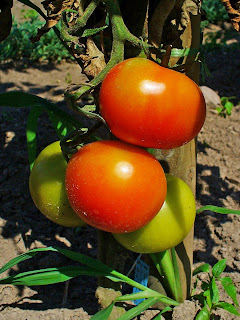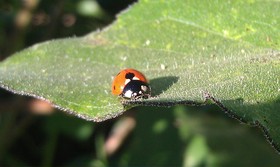 Good day happy gardeners, and happy Cinco de Mayo! Or shall I say Compost de Mayo he he he... But seriously folks in this post I wish to discuss the basics of composting and the benefits that come from having a compost pile, bin, or bucket in your backyard or kitchen.
Good day happy gardeners, and happy Cinco de Mayo! Or shall I say Compost de Mayo he he he... But seriously folks in this post I wish to discuss the basics of composting and the benefits that come from having a compost pile, bin, or bucket in your backyard or kitchen.Much like the chicken and the egg, it is hard to say which came first the compost heap or the garden but I can say that as organic gardener you can not really have one without the other. In my case, I started my first compost pile the same day I started my first vegetable garden and I have enjoyed building and tending my compost heaps just as much as my gardens.
So what is compost exactly? Well, basically compost is decomposed organic matter. Have you ever reached under the leaf litter while walking in the forest? That rich black soil like substance just beneath the leaves that has been forming over many years is compost and it is the foundation of organic gardening. In nature compost is the fertilizer and what we are trying to do in our home compost pile is to speed up and control the process that natures does so well.
When most people envision a compost pile in their minds they think of a rotting heap of garbage infested with flies, roaches, and rats. This could not be further from the truth. In fact, a properly maintained compost pile is quite unappealing to most pests. Properly maintained piles will emit no foul odor and can be hidden from view by placing them in an inconspicuous location of your yard.
There is no right way to compost, and each of you will eventually develop a method that works for you, but to get you started on the right foot, I will recommend a few different methods and some guidelines that will help you on your way. While it is true that if you take any type of organic matter, and toss it out in nature eventually it will decompose, most of us don't have decades to sit around waiting for this to occur naturally so we need to help the process along, to do this we must construct a pile with the right ratio of specific organic materials.
So it begs to reason then if you toss your garden debris into a pile and toss some fallen leaves on top give it a hose down in a few weeks you should come to find some awesome compost right? Wrong. What you'd actually find is a pile that looks remarkably similar to the one you left, only perhaps a bit dryer. The reason being you must also properly construct and maintain your pile if you want to reap the rewards of the heap!
Construction of your pile is where you get to add your own flavor, and it is the construction of piles and the techniques involved that make composting more of an art than a science, but there are two very different methods that have been developed and tested over many years that will provide a foundation. Most often organic gardeners and composters, myself included, will use a combination of two methods, the Indore Method and the University of California Method.
The Indore method was developed in India and perfected by soil scientist Sir Albert Howard. It involves building a large compost pile in alternating sandwich like layers of green and brown material and providing the proper moisture content for the microbes in the compost to work effectively. To build an Indore pile start with 40% brown material like straw or shredded newspaper, 40% green material like veggie scraps or grass clippings, and 20% manure. Alternate 6 inch layers starting with green and covering with brown. Add a 2 inch layer of manure and repeat. Provide enough moisture so that the pile has the consistency of a wrung out sponge. It should not be overly saturated or else it will deprive oxygen from the center of the pile, to little moisture and decomposition stops. The key to a successful Indore pile is size. The pile should be as large as possible, no less than 5 ft x 3 ft. Good aeration is also very critical, incorporate large twigs to provide air circulation or create air holes using rebar.
12 weeks to long to wait huh? Well than perhaps the University of California method is for you. Short of driving down to the closest sand and gravel shop and buying a yard or two of compost this is the fasted method of getting compost. This method involves chipping and shredding the material before building the pile to create more surface area as well as more frequent turning of the pile once it is built. To build a University of California or rapid composting pile first assemble the correct ratio of shredded or chipped green and brown materials as well as manure. You may also consider using an activator to get things cooking a bit faster. An activator provides a boost to the decomposing microbes that will get your pile off to a hot start. Activators include manure, meal blends like blood, bone, hoof, alfalfa etc, as well as dog food and good old fashioned native soil.
Combine the ingredients and moisten thoroughly to the consistency of a wrung out sponge. There is no need to layer the rapid compost pile because you will turn it in only 3 days. Build the pile to about 5 feet high and give the whole pile a wet down just to be safe. You can cover the whole pile with a layer of straw if you choose. You should begin to notice your pile heat up within 24 hours. After 48 hours the pile should be too hot to touch. After three days the pile will reach a climax and begin to cool, this is when you will turn your pile. After the first turn your pile will never get as hot as the first time, but it will continue to heat up and decompose very rapidly. Continue turning the pile every three days for the next 2 weeks.
As I said earlier, most of us will use some variation of one of these methods when building our piles at home. Just remember that composting in a sense is just rotting, and if you leave any material out long enough, it will rot away and compost all on it's own without any input from us. So if you choose, composting can be the most passive gardening chore you have, or that most labor intensive, it is completely up to you.
One final note, if you live in an apartment, or a perhaps a place where you do not have space to build your own pile, you can still compost at home under your kitchen sink using Bokashi. Bokashi compost buckets are what people in large crowded cities like Tokyo have used for years. Boakshi buckets are essentially composting systems that utilize microbes to ferment and consume kitchen waste. You can purchase kits for less than $100 online. Incidentally, Bokashi microbes have lots of other fabulous uses, like removing foul kitty box odors!
For further information on composting please check out the following resources and as always feel free to shoot me any questions you may have or any suggestions for topics you would like for me to cover, until next time Happy Gardening!
Let it Rot - The Gardeners Guide to Composting by Stu Campbell
The Rodale Book of Composting by Grace Gershuny and Deborah L. Martin
Bokashi Composting Systems


